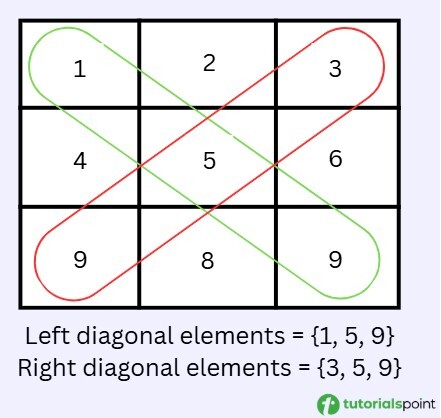
 Data Structure
Data Structure Networking
Networking RDBMS
RDBMS Operating System
Operating System Java
Java MS Excel
MS Excel iOS
iOS HTML
HTML CSS
CSS Android
Android Python
Python C Programming
C Programming C++
C++ C#
C# MongoDB
MongoDB MySQL
MySQL Javascript
Javascript PHP
PHP
- Selected Reading
- UPSC IAS Exams Notes
- Developer's Best Practices
- Questions and Answers
- Effective Resume Writing
- HR Interview Questions
- Computer Glossary
- Who is Who
JavaScript Program to Find Difference Between Sums of Two Diagonals
To find difference between sums of two diagonals, we will be discussing two different approaches. We will calculate the sum of the elements present in the left and right diagonal, then we will subtract both sum values to get the difference.
In this article we are having a square matrix, our task is to write a JavaScript program to find difference between sums of two diagonals.

Example
Input: Matrix: [[1, 2, 3], [4, 5, 6], [9, 8, 9]] Sum of left diagonal elements = 1+5+9 = 15 Sum of right diagonal elements = 3+5+9 = 17 Output: Difference: 2
Approaches to Find Diagonal Sums Difference
Here is a list of approaches to find difference between sums of two diagonals in Javascript which we will be discussing in this article with stepwise explaination and complete example codes.
Using Brute Force
To find difference between sums of two diagonals in Javascript, we have used nested for loop to iterate over each elements in rows and columns.
- We have declared a 2D array matrix and defined a function diagonalDiff() that accepts matrix as argument.
- Inside function diagonalDiff() we have declared two variables leftSum and rightSum to store the sum of left-to-right diagonal and right-to-left diagonal respectively.
- We have used nested for loop to iterate through the matrix. To calculate the leftSum, value at the same position in both the row and the column is added with leftSum.
- To calculate the rightSum, we have to add the elements whose index sum (i+J) is equal to (n-1) or i = (n-1-j).
- The absolute difference between the two diagonal sums is calculated using the Math.abs() function and returned as the result.
- The result is then displayed in web console using console.log().
Example
Here is a complete example code implementing above mentioned steps find difference between sums of two diagonals in Javascript using nested loop.
let matrix = [[1, 2, 3], [4, 5, 6], [9, 8, 9]];
function diagonalDiff(matrix) {
let leftSum = 0;
let rightSum = 0;
let n = matrix.length;
for (let i = 0; i < n; i++) {
for(let j = 0; j < n; j++) {
if (i === j) {
leftSum += matrix[i][j];
}
if (i === n-1-j) {
rightSum += matrix[i][j];
}
}
}
return Math.abs(leftSum - rightSum);
}
console.log("Difference of sum of elements of both diagonals: ")
console.log(diagonalDiff(matrix));
Optimized Approach
In this approach to find difference between sums of two diagonals in javascript we have used single for loop instead of using nested for loop as approach first.
- We have declared a 2D array matrix and defined a function diagonalDiff() that accepts matrix as argument.
- Inside function diagonalDiff() we have declared two variables leftSum and rightSum to store the sum of left-to-right diagonal and right-to-left diagonal respectively.
- We have used a for loop to iterate over elements of the matrix. The leftSum is calculated by adding the leftSum with matrix elements having same index.
- The rightSum is calculated by adding the elements whose index sum (i+J) is equal to (n-1) or i = (n-1-j).
- The absolute difference between the two diagonal sums is calculated using the Math.abs() function and returned as the result.
- The result is then displayed in web console using console.log().
Example
Here is a complete example code implementing above mentioned steps find difference between sums of two diagonals in Javascript using for loop.
let matrix = [[1, 2, 3], [4, 5, 6], [9, 8, 9]];
function diagonalDiff(arr) {
let leftSum = 0;
let rightSum = 0;
let n = arr.length;
for (let i = 0; i < n; i++) {
leftSum += arr[i][i];
rightSum += arr[i][n - 1 - i];
}
return Math.abs(leftSum - rightSum);
}
console.log("Difference of sum of elements of both diagonals: ")
console.log(diagonalDiff(matrix));
Complexity Comparison
Here is a comparison of time and space complexity of all the above approaches.
| Approach | Time Complexity | Space Complexity |
|---|---|---|
| Brute Force | O(n^2) | O(1) |
| Optimized Approach | O(n) | O(1) |
Conclusion
In this article to write a JavaScript program to find difference between sums of two diagonals we have discussed two approaches. These are: by using brute force where we have used nested loop and optimized approach where we have used a single for loop. Using single for loop is more efficient approach as it has time complexity of O(n).
Practice and learn from a wide range of JavaScript examples, including event handling, form validation, and advanced techniques. Interactive code snippets for hands-on learning.

